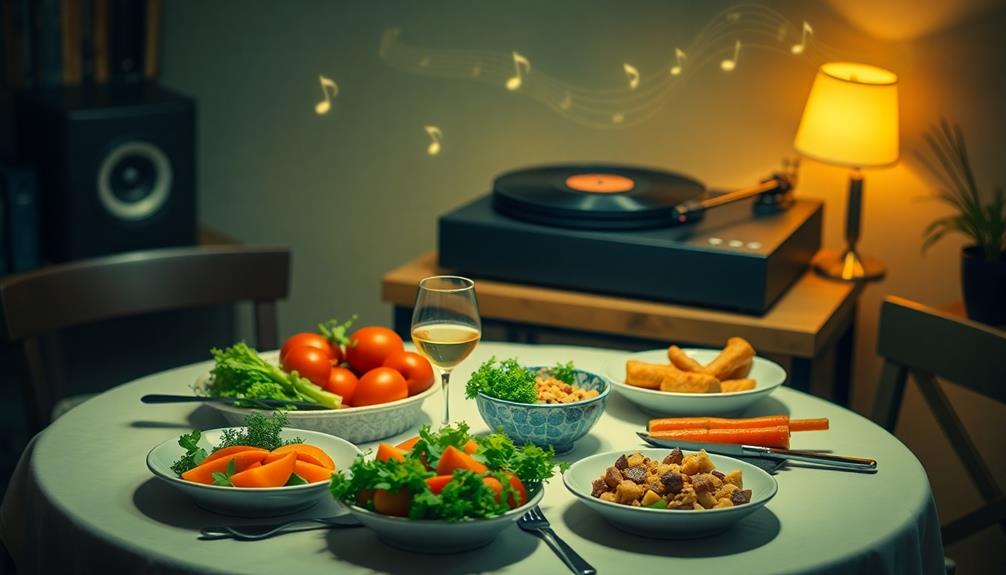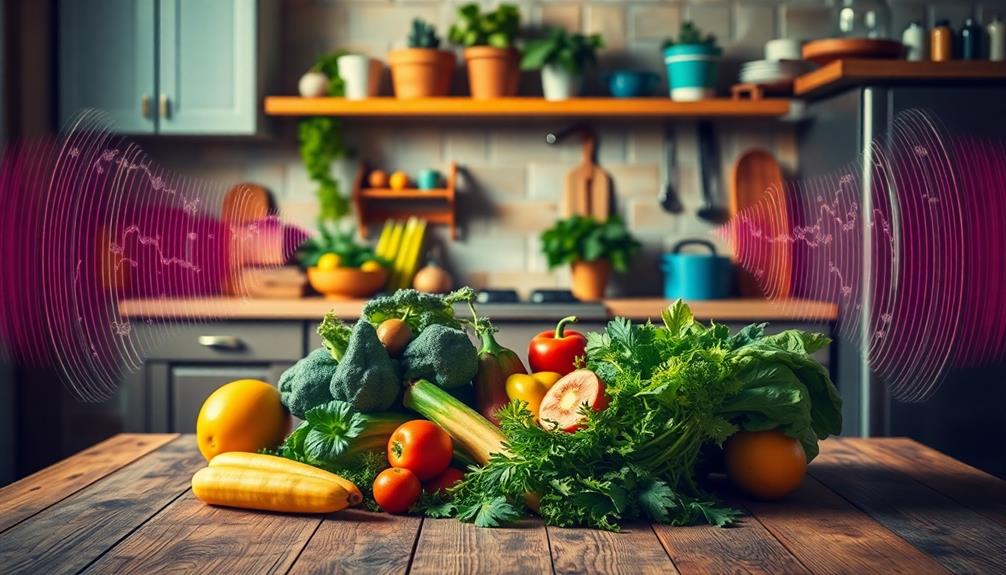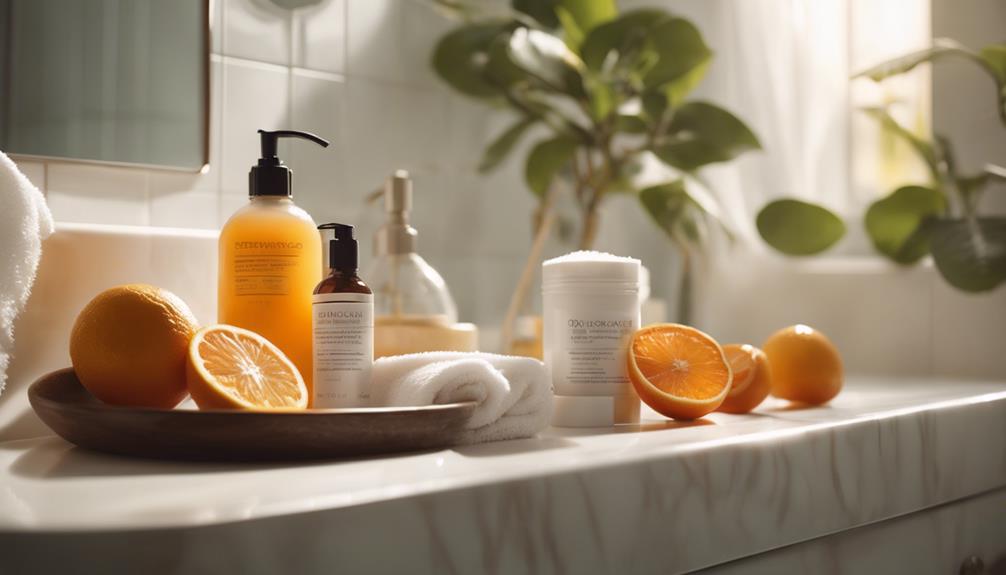Soundscapes play an essential role in how you perceive food freshness. When you're enjoying crunchy foods, the sounds they make can enhance your sense of freshness by up to 15%. Higher frequency sounds boost that perception even more, while excessive background noise can mask important auditory cues. If you find yourself in a noisy environment, it might dampen your enjoyment and even the flavors you're tasting. By understanding how sound interacts with your eating experience, you can better enhance your perception of food quality. Stick around to reveal more insights into this fascinating connection!
Key Takeaways
- Soundscapes with high-frequency sounds enhance perceptions of food freshness and crispness.
- Crunching sounds from foods can increase freshness perception by up to 15%.
- Excessive background noise can mask freshness cues, reducing flavor intensity significantly.
- Muffled or dull sounds may lead consumers to associate food with staleness.
- Strategic sound design in dining environments can elevate expectations of food quality and freshness.
The Role of Sound in Taste

Listening to the sounds of your food can greatly enhance your tasting experience. When you crunch into a fresh apple or crack open a crispy chip, those sounds play an essential role in how you perceive the food's quality. For instance, the auditory experience of enjoying a Graveyard Taco Dip during a Halloween gathering can make the layers of flavors even more delightful.
Research shows that the auditory cues generated by crunchiness can increase your perception of freshness by as much as 15% when sounds are amplified. This means that the delightful crispness you hear isn't just background noise; it directly impacts how enjoyable your meal is.
Your brain automatically integrates sounds and tastes, influencing your overall experience. Factors like jawbone conduction and airborne sounds create a rich tapestry of auditory feedback as you eat.
However, be aware that excessive background noise—over 100 decibels—can detract from this experience, leading to a diminished sense of food quality. The synergy of sound and taste is powerful, making every crunch a part of the culinary narrative.
Sound and Food Freshness

When you bite into a crisp apple, the sound it makes plays a vital role in how fresh you perceive it to be. Research shows that louder crunching sounds can boost your sense of freshness by as much as 15%.
Similarly, the auditory experience of enjoying a dish like Red-Braised Pork Belly, with its tender texture and rich flavor, can enhance the overall perception of freshness.
On the flip side, if you're in a noisy environment, that background noise could ruin your enjoyment and diminish your perception of the food's quality.
Auditory Cues and Freshness
Auditory cues play an essential role in shaping your perception of food freshness, as the sounds associated with eating can greatly influence your overall experience. Research shows that loud crunching sounds can enhance your perception of freshness, with amplified sounds increasing perceived crunchiness by 15%.
When you hear the sound of chewing or crunching, your brain automatically integrates this auditory feedback, connecting it to food texture and freshness perception. For example, the satisfying crunch of onion rings can reinforce the idea of freshness, making the eating experience more enjoyable.
High-frequency sounds are often linked to fresher, crisper foods, while lower frequencies can suggest staleness. This interaction between sound and taste can considerably affect how you enjoy your meal. For instance, when you hear those satisfying crunches, it reinforces the idea that the food is fresh and appealing.
Studies have also demonstrated that manipulating food sounds through headphones can alter your freshness perception, further highlighting the importance of auditory cues in your eating experience.
Background Noise Influence
Background noise can greatly alter your dining experience, especially when it comes to perceiving food freshness. The impact of background noise on food can markedly affect your taste buds and overall enjoyment.
Studies indicate that louder environments can diminish the flavor intensity by 20-30%, particularly affecting sweetness and saltiness. However, it's crucial to reflect on how different types of noise might also influence your perception of food.
Here are three ways background noise affects your dining experience:
- Masking Freshness: Environmental sounds in restaurants can mask the auditory cues that signal food freshness, reducing your overall enjoyment.
- Crunchy Sounds: Louder crunching sounds can enhance the perception of freshness, with a noted 15% increase in perceived crunchiness.
- Frequency Matters: High-frequency sounds associated with crunchy foods contribute positively to freshness perception, while low-frequency sounds may not have the same effect.
Ultimately, the interplay of background noise and food perception is complex. Paying attention to the sound environment can help you appreciate the freshness of your meal more fully.
Texture Perception Through Sound

When you crunch into a fresh potato chip, the sound you hear plays a big role in how you perceive its texture.
Higher sound frequencies enhance that crispness, making the experience even more satisfying.
It's fascinating how auditory cues can elevate your enjoyment of food and even influence your perception of its freshness.
Sound Frequency and Crispness
Sound frequency plays an essential role in how you perceive the crispness of food. Higher frequency sounds tend to be associated with the sensation of freshness and crispness, greatly impacting your overall food perception. Studies show that louder crunching sounds can enhance your perception of freshness by up to 15%.
Here are three key points about sound frequency and crispness:
- Crispy vs. Crunchy: Crispy foods generate higher-frequency sounds, while crunchy foods produce lower-frequency sounds, affecting your texture perception.
- Auditory Manipulation: Altering the sound you hear while eating can change how you perceive the texture; for instance, reduced biting sounds often lead to softer texture ratings.
- Automatic Integration: Your brain automatically integrates auditory stimuli with tactile information, enhancing your enjoyment of foods with crispy textures by reinforcing their perceived freshness.
When you eat, those auditory cues, like the crunch of potato chips, not only inform you about the texture but also elevate your eating experience.
Auditory Cues and Freshness
Perceiving freshness in food goes beyond just taste and texture; auditory cues play an essential role in this experience. The crunching sounds of fresh foods greatly contribute to your perception of food freshness. Research shows that louder sounds can increase perceived crunchiness by 15%. You may not even realize it, but sound changes can alter how you perceive texture without your conscious awareness.
Here's a quick overview of how different auditory cues affect your experience:
| Sound Type | Effect on Freshness | Example |
|---|---|---|
| High-Frequency Sounds | Increase perception of freshness and crunchiness | Biting into an apple |
| Low-Frequency Sounds | Diminish perception of freshness | Chewing soft bread |
| Crunching Sounds | Enhance enjoyment and texture perception | Snapping a carrot |
| Muffled Sounds | Associate with staleness | Eating a soggy chip |
The mechanism of jawbone conduction even transmits these sounds directly to your inner ear, integrating auditory and tactile information. So, the next time you enjoy a crunchy snack, remember that those delightful sounds are enhancing your overall sensory experience!
Texture Enhancement Through Sounds
Auditory cues not only influence your perception of freshness but also considerably enhance how you experience food texture. When you munch on crunchy foods, the sound they produce plays a pivotal role in how you perceive their texture. Research shows that louder crunching sounds can lead to a 15% increase in perceived crunchiness, highlighting the importance of sound in your culinary experience.
Here are three ways auditory cues contribute to texture enhancement:
- Sound Quality: The crackling and crunching sounds provide essential feedback about the food's freshness and quality.
- Sensory Integration: Manipulating sound through headphones can alter your perception of texture, indicating the brain's reliance on auditory feedback during eating.
- Jawbone Conduction: This phenomenon combines airborne sounds with tactile sensations, further influencing how you perceive texture.
In essence, the sounds associated with crunchy foods not only signify their freshness but also heighten your overall enjoyment.
Environmental Soundscapes and Dining

The impact of environmental soundscapes on your dining experience can be profound, often shaping how you enjoy your meal. High levels of background noise, especially over 100dB, can diminish your perception of food quality and alter your enjoyment of taste and smell.
When you're surrounded by loud sounds, subtle flavors can get masked, leading to a less satisfying meal.
Interestingly, the type of background noise can also influence your expectations and perceptions. For instance, louder environments might enhance the crunchiness of your food, making it seem more appealing, while simultaneously dulling the sweetness or saltiness you might expect.
This dual effect can shift your overall dining experience, affecting not only what you think about the food but also what you choose to order.
Practical Applications in Food Marketing

Soundscapes aren't just about enhancing your dining experience; they also play a key role in food marketing strategies. By incorporating specific background sounds, you can influence consumer perceptions of food quality and freshness.
Here are three practical applications you can consider:
- Themed Auditory Experiences: Use sound design to create an environment that aligns with your food choices. For example, the sound of sizzling when promoting grilled dishes can enhance perceived quality.
- Packaging Sounds: Integrate crinkling or crunching noises into your product packaging. These sounds can elevate expectations of freshness and quality as customers open the product.
- Retail Environment Soundscapes: Create an atmosphere filled with appealing sounds like crunching or sizzling. Research shows that these sounds can lead to increased sales by fostering associations with freshness.
Noise Levels in Restaurants

Drowning in the clamor of a bustling restaurant can greatly detract from your dining experience. Research shows that noise levels in many eateries often exceed 100 decibels, which can negatively impact your food perception. In such loud environments, subtle taste sensations get masked by background noise, leading to diminished enjoyment of your meal.
Interestingly, studies have revealed that heightened noise levels can enhance your perception of crispy foods. You might find that the crunchiness stands out more, but this comes at a cost—sweetness and saltiness in your dishes may be suppressed. This imbalance can leave you feeling less satisfied with your meal.
Critics have noted that the growing noise levels in restaurants might make dining less pleasurable, potentially deterring you from returning. In addition, consistent exposure to high noise levels doesn't just affect your enjoyment; it can also pose risks for restaurant staff, such as hearing damage, and it detracts from the quality of customer interactions with food.
Ultimately, the noise in these settings can greatly shape your overall dining experience, influencing not just what you taste but how you feel about your meal.
The Perfect Soundtrack for Meals

Curating the perfect soundtrack for your meal can transform your dining experience. The right background music enhances the flavor of the food, elevating your enjoyment and perception of freshness.
By carefully selecting a soundtrack, you can create an immersive environment that complements your meal. Here are three key factors to evaluate:
- Mood: Choose music that evokes positive emotions. Happy tunes can enhance the perceived value of your food, making each bite more enjoyable.
- Volume: Keep the background music at a moderate level. Too loud, and it diverts your attention from the meal; too soft, and it mightn't create the ambiance you desire.
- Genre: Match the music genre to the cuisine. For example, classical music may enhance a fine dining experience, while upbeat tunes could complement casual meals.
Future Directions in Sensory Research

As you explore how music influences your dining experience, it's exciting to contemplate the future of sensory research in this area. Future research will investigate individual differences in how sound shapes food perception, revealing the variability in sensory responses among different consumers. Understanding these differences can enhance the dining experience by tailoring soundscapes to individual preferences.
Additionally, researchers will continue to examine the crossmodal interactions between sound and taste. By analyzing how auditory stimuli affect flavor experiences, they aim to deepen our understanding of multisensory integration. Emerging technologies, like virtual reality and immersive audio, will provide controlled auditory environments during food consumption experiments, allowing for more precise data collection.
Moreover, the role of cultural influences on the relationship between sound and taste remains largely unexplored. This indicates a significant opportunity for diversified research that considers cultural contexts and their impact on sensory experiences.
Frequently Asked Questions
How Does Noise Affect the Perception of Food and Drink?
Noise impacts your perception of food and drink by altering flavor intensity and enjoyment. You might find sweetness diminished or crunchiness enhanced, affecting your overall dining experience and potentially influencing what you choose to eat.
How Does Sound Affect the Taste of Food?
Sound influences your taste experience considerably. When you hear crunching or sizzling, it enhances your perception of texture and flavor, making food seem fresher and more enjoyable. So, pay attention to the sounds while you eat!
How Does Hearing Affect Our Perception of Flavor?
When you hear crunching, you feel freshness; when you hear silence, flavors fade. Your perception of flavor shifts with sound, enhancing enjoyment and altering your taste experience, making every bite a symphony for your senses.
Does Food Taste Better in a Quiet Room?
Yes, food often tastes better in a quiet room. Without loud background noise, you can fully appreciate the flavors and textures, enhancing your overall dining experience and making each bite more enjoyable and satisfying.
Conclusion
To summarize, soundscapes greatly influence how you perceive food freshness and taste. As the saying goes, "you eat with your eyes first," but it's also true that what you hear can enhance or detract from that experience. By understanding the power of sound in dining, you can elevate your meals and create a more enjoyable atmosphere, whether at home or in a restaurant. Embrace the right sounds, and let them transform your culinary adventures.










